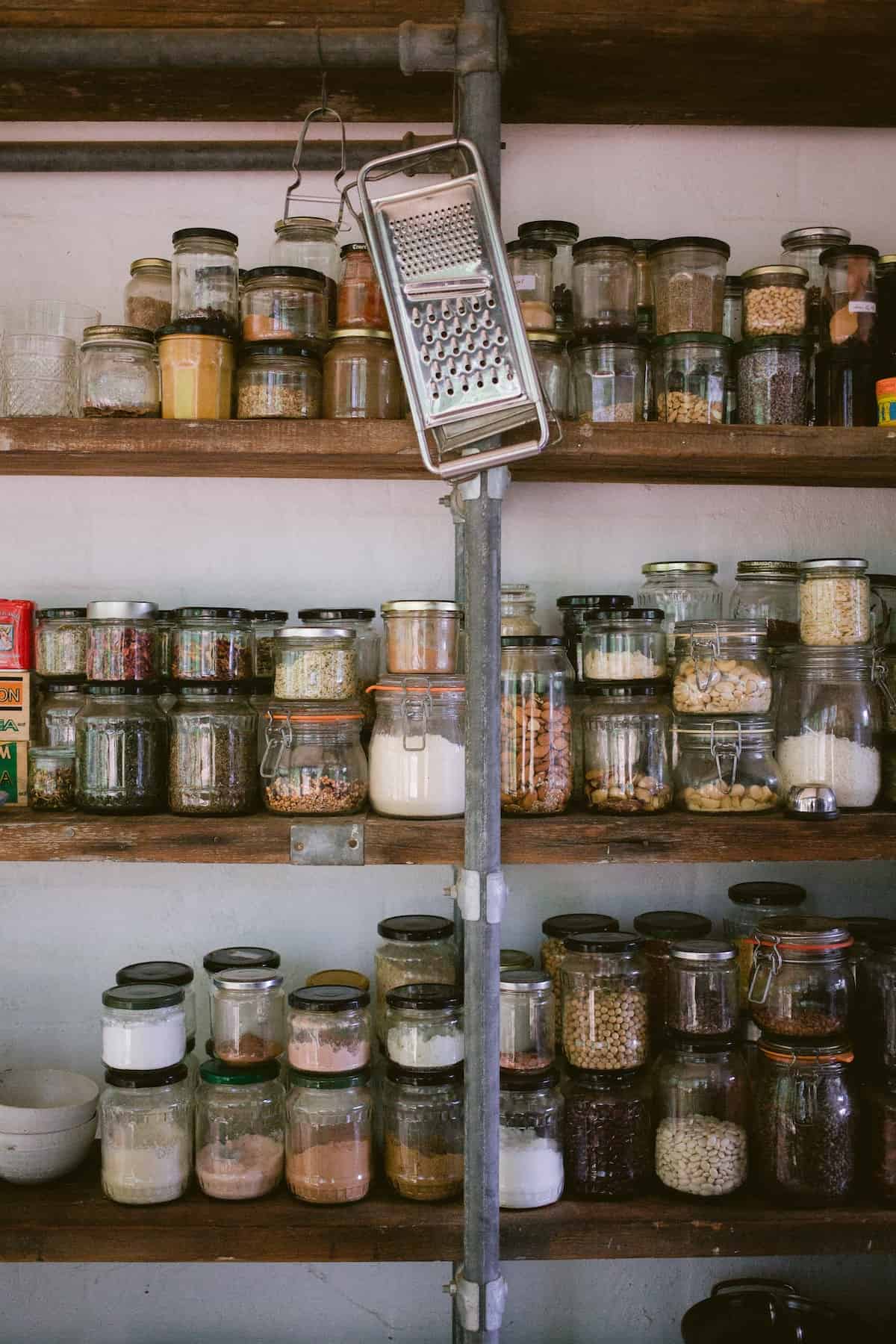As we welcome the fresh start of a New Year, it's the perfect time to embrace a fun, wallet-friendly challenge. Welcome to No Spend January, The Grocery Edition! 🛒✨

Whether you're a seasoned budgeter or just dipping your toes into the world of smart grocery spending, this challenge is for you. It's all about using what's in your pantry, which in turn helps reduce waste. Plus, think of all the savings! Trust me: there’s no better way to help your wallet bounce back after the *ahem* enthusiasm of the holiday season.💰😉
Jump to:
- What Is No Spend January?
- Planning & Preparation
- The Magic of Monthly Savings
- Together We Cook: Fostering a No-Spend Community
- Conquer Your Cravings
- Resources & Tools: Your Arsenal for a Successful No-Spend January
- Vegetarian Pantry Meals
- Omnivorous Pantry Meals
- Pantry-Based Sides
- Breakfast From The Pantry
- Simple Pantry Sweets & Treats
- Nutrition & Health Considerations To Keep In Mind
- More Recipe Roundups & Resources
- 💬 Reviews
What Is No Spend January?
The idea behind this challenge is beautifully simple: for the entire month of January (or whichever month you choose), you commit to not spending money on non-essential items. If you’re thinking 'Does this mean I can't buy anything at all?' the answer is, not quite.
The focus of No-Spend January is on cutting out unnecessary spending. Essentials like rent, medications, and all your other basic necessities are still in the picture. The real challenge is identifying what's truly “must-have” vs. what’s “want.”
In the Grocery Edition of this thrifty challenge, we’re zeroing in on one of the most common areas of spending: our food budget. Don’t worry, this doesn't mean you have to eat only beans and rice all month or relive the ramen-filled days of college (though this ramen glow-up is well worth trying).

The point is challenging yourself to be resourceful with what you already have in your kitchen and avoiding grocery store trips unless absolutely necessary (i.e. you don’t have enough in the house to pull together a meal).
Consider this challenge a fun opportunity to get creative in the kitchen, try new recipes, and appreciate the abundance that likely already exists in your cupboards. I like to think of it as a treasure hunt — as you clean out the pantry, you’ll find things you forgot you had.
At the end of the day, the challenge isn’t just about saving money — though that’s worth it enough. It's about embracing simplicity (fewer grocery trips means more time in your schedule!), reducing waste (if you find tossing food as repulsive as I do, this is a huge bonus!), and finding joy in the small things – like that can of chickpeas waiting to be transformed into a scrumptious Mediterranean bake. (Oh, and don’t forget the aquafaba — it’s perfect for replacing eggs!)
Planning & Preparation
If the idea of not grocery shopping for a month has you freaking out, take a deep breath. I’m gonna break down how to do a no-spend challenge into more manageable, bite-sized chunks.
Taking Stock of Your Stock
First things first, let's figure out what goodies are hiding in your pantry, fridge, and freezer. It's inventory time! Grab a notebook (or your favorite digital tool) and make a list of everything you have. Check the dates, organize by categories (like grains, canned goods, spices), and get a clear picture of your starting point.

Meal Planning Magic
Now, with your inventory in hand, it’s time to get creative with meal planning. The goal is to use what you have, minimize waste, and keep things exciting. Here are a few tips:
- Mix and Match: Look at your list and start pairing items together. Got pasta and canned tomatoes? Hello, spaghetti night! Rice and beans? That's a deliciously hearty vegetarian meal waiting to happen. Sweet potatoes and canned fish? Salmon cakes to the rescue!
- Theme Nights: Meatless Monday, Taco Tuesday, Stir-Fry Saturday... there are plenty of themes to choose from! Using a template for at least a few days out of the week takes some of the guesswork out of meal planning, plus it’s fun!
- Flexibility is Key: Learning how to swap ingredients in recipes based on what you have is a skill all home cooks should master. For all you strict rule-followers out there, this might be the toughest part of the challenge. It’s also going to be the part that makes you a better, more well-rounded cook! (For some very useful pairing advice, you can’t beat The Flavor Thesaurus and The Flavor Bible.)
When in Doubt, Gimme a Shout!
Stumped on what to make with certain ingredients? That's where I come in! Feel free to reach out to me in an email for some recipe riffing. Or, you can always ask ChatGPT or do a quick Google search for inspiration. Trust me, there's a whole wide world of recipes waiting for those random bags of dried beans or that one lonely squash.
If you’re looking to invest in some online resources, I wholeheartedly recommend Epicurious and New York Times Cooking subscriptions. You can always ask for them as gifts if you’re not ready to take the plunge! (P.S. They always seem to go on sale around the holidays. 😉)
Must-Haves and Allowable Cheats
Yes, we’re trying to avoid the grocery store, but I like to write out a list of “cheat items” I’m allowed to purchase throughout the month. I like to set a budget of no more than $10/week for my groceries during the challenge, but your personal spending amount will depend on how deep your pantry reserves are. I’m also lucky to live by an Aldi, which makes that budget very attainable.
So, what’s on my list? First, a few items from the produce department. Basic aromatics (i.e. garlic, onions, carrots, and celery) are inexpensive, long-lasting, and are the basis for countless soups, sauces, casseroles, and more. I also allow myself to purchase cheap, in-season fruits like apples or bananas.
Don’t forget a few dairy cheats: salted grass-fed butter and full-fat Greek yogurt are hard workers in my house. Finally, while I’m working my way through all the shelf-stable milks and heavy cream powder I keep on hand, once that runs out, it’ll be one of my cheats. What can I say? I’m a sucker for making fancy homemade coffees and homemade ice cream.
But again — I have to stick to just $10 a week. If I buy my favorite butter from Aldi, that eats almost half of my weekly grocery allowance. Or if I get a container of oat milk, a third of my budget is spoken for. It’s a fun little strategy game figuring out how to get all the necessities while still staying within budget!
Also, remember that your cheats don’t have to be my cheats. When I surveyed some of my blogger friends as to what theirs would be, I got a wide range of answers. For example, Heather from FitMamaRealFood chose eggs, bananas, peanut butter, sweet potato, and avocado. For some of my vegan buds, tofu and canned chickpeas were high on the list. Figure out what yours are, then stick to your guns.

Smart Shopping Strategies
If you do need to shop, here are some strategies I use to stay on track:
- Stick to the List: Only buy what you absolutely need. That’s why I like to write out my cheat list and weekly budget ahead of time, then keep it posted to the fridge. And then write “No Cheating” on it. 😂
- Avoid Temptation: Many grocery stores are built to encourage wandering. (That’s why I love the small footprint of Aldi and Trader Joe’s!) Stay away from the aisles that don’t have what you’re looking for. You can also order for grocery pickup or delivery to avoid the temptation in the first place.
- Nominate a Surrogate Shopper: If you have a spouse or roommate who isn’t as much of a grocery addict as you, you can delegate shopping responsibilities to them for the month. (Thanks to my sweet hubby Joe who is always my surrogate shopper.)
- Shop with Purpose: Get in, get what you need, and get out. When Joe is out of town or unavailable, I’m responsible for any grocery runs. When that’s the case, I make an extra challenge out of it — I set the timer on my phone for 5 minutes, and once it goes off, I have to head to the checkout line! This keeps me from having time to become tempted.
- Cash Stuffing: Using a simple system like stuffing cash into envelopes to keep you on budget is low-tech enough that anyone can do it. If you’re going to the grocery store, only bring the amount you’ve designated as your cheat spend for the week — then there’s no possible way you can overspend!

Mastering Meal Prep
When you do cook, think bulk! Cooking grains, beans, or proteins? Double up the amount. This way, you have a base ready for different meals throughout the week. And it doesn't have to be a specific meal prep day – just 'next-over' it. Cook once, eat twice (or, mayhaps, thrice?)!
Finally, don’t forget the magic of the freezer. We’re just a 2-person household, so most recipes will make enough leftovers for at least one more meal. Even so, I still like to double up on recipes and then freeze half. The effort involved in doubling most recipes is negligible, especially since you’re gonna have to do dishes anyway!
Then, when a night pops up that you’re too tired/busy/cranky to cook a few weeks down the line, just grab your freezer meal and reheat it. I’ve become obsessed with Pyrex storage containers for just this purpose — since the base is made from borosilicate glass, it can go from freezer to microwave or oven. Just don’t bake the lids!
The Magic of Monthly Savings
Let's see just how much you can save by embracing this challenge with some real numbers. I'll use myself as a case study. Typically, I spend about $125 per week on groceries. But, for the challenge, I'm limiting myself to just $10 per week for my "cheat list."
Now, let's do some back-of-the-envelope math, using 4 weeks of our budget:
- Normal monthly grocery budget: $500
- No Spend January budget: $40
- Potential savings: $500-$40 = $460
$460 ain’t too shabby, y’all! Imagining what I could do with that extra cash is enough of a reason to try the challenge in the first place. Maybe I'll take a mini-vacation, or use that as my budget for Christmas gifts next year. 🤔
I strongly encourage you to run the numbers for yourself and your grocery budget. Then, when you know what your savings will be, figure out what you can do with that money and put up a sticky note on the fridge to keep you motivated throughout the month. You can also let me know in the comments below so I can cheer you on!
As they say, a penny saved is a penny earned. So, when the going gets tough, remember to celebrate each dollar saved as a step towards financial freedom!

Together We Cook: Fostering a No-Spend Community
This No Spend January, embrace the power of community. By supporting each other through the process — sharing our hardships (I overcooked the potatoes!) and celebrating our wins (I made this crazy dish last night that tasted SO GOOD) — what might otherwise feel like a chore becomes a fantastically delicious way to keep in touch!
Joining Hands in the Challenge
Accountability buddies are my preferred way to start new habits. Find a group of friends or neighbors who are interested in taking on the No Spend challenge with you. Set up a standing weekly meeting, then create group rules. Here are some I’ve tried in the past:
- Implement a rotating schedule for each of the members to host one meal.
- Allow 1 cheat night of ordering out.
- Set up pantry swaps with each other (e.g. if you’re out of sugar, you can come shop my pantry without breaking the challenge because you’re not paying for it).
- Keep up with your CSA, but don’t buy anything else. (If you need in-season cooking inspiration, check out my friend Frances over at Cooking With Our CSA.
Recipe Exchange and Soup Swaps
Sharing is caring, especially when it comes to recipes and yummy food! Here are some of my favorite ways to spread the love:
- Recipe Exchange: I don't know about y'all, but my friends and I talk about food A LOT. Create a group recipe exchange, where everyone can offer up their favorite meals that can be made with limited ingredients. Don't feel like you have to be super precious about it — feel free to use casual measurements like "a handful of this" or "a big pinch of that."
- Host a Soup Swap: This is one of my favorite annual traditions, and it's perfect for the No-Spend challenge! Soups, chilis, and stews are great for clearing out the pantry, fridge, and freezer. Plus, chances are that no two participants' pantries are identical, so there will be tons of variety in what soups get made. To explain it briefly, each person makes a large batch of soup, divvies it into enough individual portions for the crowd, and brings them to the event. For each portion you bring, you take a portion of someone else's. It's SO FUN and is my favorite way to stock the freezer.

Celebrating Creativity and Success
Don’t forget the power of celebrating your wins! Whether it's a humble brag about the delicious homemade sourdough you made or sharing the fact that you went to the store and only got what you needed, taking the time to recognize your accomplishments (and those of your fellow No-Spenders) is a great way to stay motivated. Here are a few ways to try:
- Weekly Check-ins: Have virtual or in-person check-ins to discuss how everyone is doing, share your kitchen stories, and offer each other support. My gals and I like to go on a weekly walk so we can double up on exercise and buddy time.
- Get Social: If an online presence is more your style, use platforms like Instagram or Facebook to share your progress, recipes, and experiences. (Full disclosure: I’m much more likely to respond to an email than an Insta post, so make sure your whole crew is on board with whatever primary sharing method you choose!)
- Photo Sharing: Post photos of your dishes to keep your group motivated. You can even start weekly photo challenges like 'Most Creative Leftover Transformation' or 'Pantry Staple Spotlight' to keep things spicy. Pro Tip: Create a fun hashtag for your group to track everyone’s posts. Bonus points for a fun team name! I vote for “Cents-less Chefs.” 🤓

The Joy of Cooking Together
If your enthusiasm begins to wane as the month goes on, consider hosting a group cooking day. It's a great way to make labor-intensive recipes (like homemade pierogis or tons of tamales), but can also be great for basic meal prep. When you're in the kitchen with your besties, it's hard for cooking to feel like a chore!
Conquer Your Cravings
One of the hardest parts of the no-spend challenge is dealing with pesky cravings. We've all been there – you're doing great, and then suddenly, you want X thing so bad, you’re on your way to grab the car keys. Or you find yourself itching to make a quick grocery run for just 'one little thing' when you know you’ll come out with 10. (🙋🏼♀️It me!)

Here are some of my favorite strategies to keep my resolve strong and my shopping cart empty:
- Get Creative in the Kitchen: Craving a chocolate candy bar? How about eating a handful of chocolate chips with some nuts (or better yet, bake up some oat flour chocolate chip cookies), or using cocoa powder to make brownies, chocolate marshmallow ice cream, or homemade hot cocoa mix instead? Dying for some pasta, but don’t have any on hand? Make your own! Have salsa but no tortilla chips? Try pouring it on top of a baked potato with some cheese and Greek yogurt. Tossing random ingredients together is how I’ve discovered some of my favorite snacks!
- Visual Reminders: Keep a visual reminder of your No-Spend goals on your fridge or in your wallet. It could be a picture of what you’re going to do with the extra money, a post-it note with how much money you’ll be saving, or a daily mantra (e.g. My wallet is closed, but my possibilities are open). Use whatever motivates you!
- Indulge in No-Spend Rewards: When you successfully resist a craving or an unnecessary trip, try rewarding yourself with a non-food treat. Maybe watch an extra episode of your favorite TV show, give yourself a mani/pedi, or plan a catch-up session with one of your favorite humans. If you’re still craving after that…
- …Get Inspired: Watch a cooking show, flip through a cookbook, or browse the web for some fresh, fun alternatives to what you normally go for.

Resources & Tools: Your Arsenal for a Successful No-Spend January
Sticking to your no-spend goals is a challenge, but there are lots of things that can help. Whether you're an analog list-lover, a high-tech app aficionado, or a bookworm, I've got something special for you. Let's dive into this well-stocked pantry of resources to help you plan, track, and enjoy every step of your no-spend journey.
- My Grocery Guide: First, don't forget to download your free copy of my Grocery Guide! It's packed with printables, pantry recommendations, and tips to kickstart your No Spend January. Consider it my little gift to you to make this month-long pantry-raid smoother and more fun.
- Inventory Management: Consider using a spreadsheet to keep track of what’s in your pantry, fridge, and freezer. Knowing what you have on hand is half the battle of meal planning!
- Meal Planning Apps: Explore apps like Mealime or Paprika that offer meal planning and grocery tracking features. These are amazing tools to help you organize your pantry inventory and plan meals based on what you have.
- Budget Tracking Apps: Keep a close eye on your spending with budget apps like YNAB (You Need A Budget). As a bonus, they’re great for your holistic budget, as well as more granular spending categories (e.g. food, rent, entertainment, utilities).
- Cook90: If you’re looking for an added layer of the No-Spend challenge, Cook90 is a fun one where you commit to cooking all your meals for a month. This NYT challenge perfectly complements No Spend January by keeping you focused and inspired in the kitchen!
- Libraries: Let’s not forget about the treasure trove that is your local library! Libraries are a fantastic resource for cooking magazines (especially digital ones!), recipe books, and sometimes even expensive kitchen equipment like ice cream makers or stand mixers. Plus, with the Libby app and Kanopy app, you can access tons of digital resources right from your phone or tablet. It’s a great way to get your inspirational fix without spending a dime!
- How to Stock Your Pantry Like a Chef: My friend and fellow food blogger Cheyanne from No Spoon Necessary has a great post on what delicious items she keeps in her pantry. She’s an honest-to-goodness bona fide chef, so you know she’s got some keepers in there.
- How to Half a Recipe: If you don’t quite have enough of whatever ingredient on hand to make a full recipe (or if you’re just not sure you want to risk using your precious resources on a recipe you’re unfamiliar with), knowing how to convert tricky measurements is a great skill to have.

Okay, now that you know the deal about No-Spend January, it’s time to start plotting what delicious things you’ll cook. Here’s a list of my favorite pantry-based recipes. If you have favorites of your own, let the world know in the comments below!
Vegetarian Pantry Meals












Omnivorous Pantry Meals









Pantry-Based Sides






Breakfast From The Pantry










Simple Pantry Sweets & Treats










Nutrition & Health Considerations To Keep In Mind
Since everyone’s pantries look a little different, I figured I’d get some advice from my friend Mackenzie Burgess, RDN on how to stay healthy during a no-spend month. She’s a registered dietitian nutritionist and recipe developer at Cheerful Choices, so she knows what’s up on the nutrition front. Here’s what she had to say:
“Even when you're working with limited grocery resources, it's important to make sure each meal is balanced with carbohydrates, protein, and fats.”
Mackenzie Burgess, RDN
She continues, “For carbohydrates, stock up on whole grains like brown rice, quinoa, and oats, which are not only affordable but also provide essential vitamins, minerals, and fiber. Lean on pantry proteins such as canned chicken, tuna packets, canned beans, lentils, and chickpeas; they're cost-effective and versatile for a variety of dishes.
Don't forget healthy fats too — staples like olive oil, nuts, and seeds can be used in small amounts to add both flavor and essential fatty acids to your meals. Lastly, add in those veggies whenever you can. Oftentimes canned or frozen can be cheaper and are just as nutritious as fresh!”

More Recipe Roundups & Resources






From conquering pantry challenges to crafting budget-friendly meals, now you know all my best tips and tricks to help you navigate this no-spend month like a pro. Keep me posted on your adventures – I can't wait to hear all about how the No-Spend January Challenge treats you. Until our next kitchen adventure, here’s to a January filled with joy, savings, and scrumptious success!





Megan says
I seriously love the idea of having "no spend" months for groceries. I went through my pantry and both of my freezers at the beginning of this month and found so many things that needed to get used. Thank you for the great ideas 🙂
Ash, The Grocery Addict says
Hooray! I'm so glad you found some inspiration and were able to save some $$$!